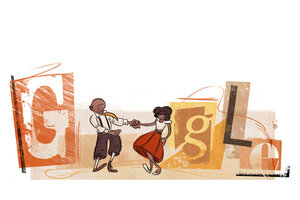How Harlem's Frankie Manning put a little swing in America's step
Frankie Manning helped bring swing dance from Harlem's Savoy Ballroom to the world stage.

Google honors Harlem swing dancer Frankie Manning on what would have been his 102nd birthday.
Courtesy of Google
The popularity of swing dancing can typically be traced through the long career of Frankie Manning.
From the early 1930s until the late 1950s, the Swing Era flourished as Mr. Manning changed the style of dance with the popular "Lindy Hop." But when rock-and-roll (and then disco) eclipsed swing in popularity, Manning took a 30-year hiatus from the dance floor, serving in the military during World War II and working at his local US Post Office. Manning began dancing swing again with the rest of the world in the early 1990s, winning a Tony Award for Best Choreography in the Broadway show "Black and Blue."
Thursday’s Google Doodle honors the American dancer on what would have been his 102nd birthday.
"Known as the Ambassador of the Lindy Hop – the exuberant style born in Harlem – Frankie Manning is remembered as the first person to take swing from the dance floor to the air above it," writes Google in a blog post. "Today’s doodle by Nate Swinehart celebrates Frankie Manning’s acrobatic, powerful style, in which his partners were flipped and spun to the emphatic horns of Count Basie, Duke Ellington, and others."
Coined the Lindy Hop after Charles Lindbergh’s solo "Hop" across the Atlantic ocean in 1927, the dance fused together jazz, tap, and Charleston to create a new, more active variety of swing. Video clips of Manning’s Lindy Hop show the dance as frenzied and spontaneous, with the female partner often being flipped and thrown in the air.
Manning’s career not only traces the history of swing, but it is also illustrative of the racism and prejudice African-Americans faced during the early to mid-20th century.
Despite the Lindy Hop’s origins at the Savoy ballroom in Harlem, a home to African-American culture in the 1920s and 1930s, white dancers soon claimed the Lindy as their own.
"And when white Americans started doing the Lindy Hop in the 1930s and '40s, renaming it the jitterbug, they erased the black performers who created it," writes Vox’s Libby Nelson. "A 1944 instructional movie on doing the jitterbug features a white couple and emphasizes that the dance borrows moves from ballet, waltzes, 18th-century ballroom dance, and ‘Javanese’ dancing – but it doesn’t mention the Savoy."
After impressing fans in Harlem with his new interpretation of swing, Manning joined Herbert “Whitey" White’s Lindy Hoppers dance troupe. The troupe was featured in numerous films during the 1930s such as "A Day at the Races" and "Radio City Revels" but all of their performances went uncredited.
"Frankie Manning often described the dance as a ‘series of three-minute romances,' " adds Google. "Here’s to the Ambassador on what would have been his 102nd birthday, and his role in creating for countless people – even if it lasted only three minutes – a moment that transcended the world around them."

